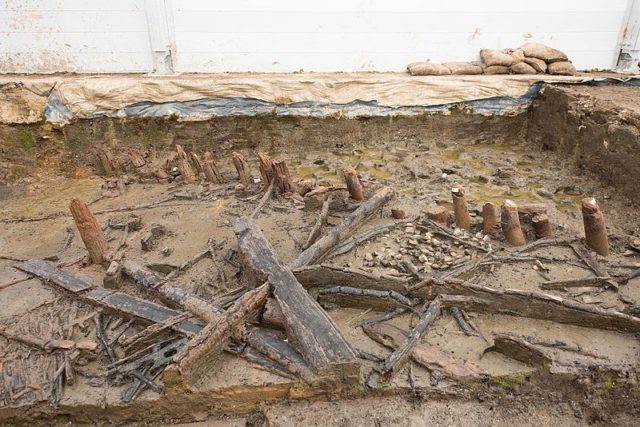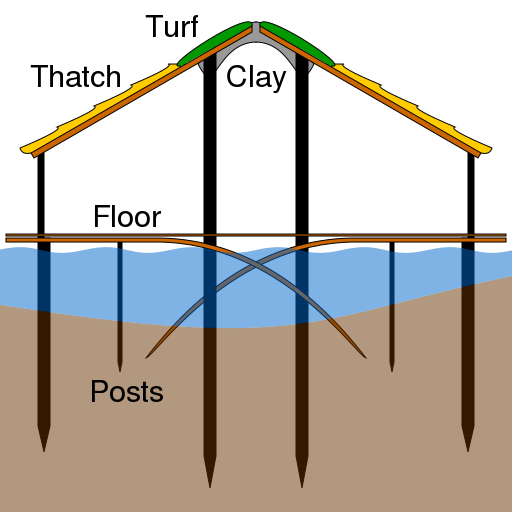It was once an active community in trade, culture and farming before it abruptly and dramatically burned to the ground. Presently archaeologists believe they have discovered information that proposes the Bronze Age village, rising from the mud within Cambridgeshire, was annihilated soon after it was built. They also believe that the embryonic colony, created on the edge of a marshland close to Peterborough, might have been annihilated in a raid by warriors, and possibly from a rival group.

Archaeologists say far from being plain homes, the buildings they have exposed are well formed homes, with several of the primary fixtures, and fittings still preserved within the mud. Amongst the items they have found from the sticky and thick river sediment are foreign glass beads possibly from the Mediterranean. A cauldron handle, a bronze dagger, bronze stick head and a curved brooch have also been dug up. Clothes created from lime tree bark, and woven textiles that might have been utilized for a rug, or wall hangings. Bowls, cups, and clay jars have also appeared from the wreckage.
Even despite this it appears the only victims to have passed away in the flames were two dogs, which were living in round wooden houses when they fell into the River Nene in Whittlesey. Artifacts found at the site, which has been nicknamed the Pompeii of the Fens, unveil a thriving community that was wealthy for their time. Decorative beads created from amber, jet and glass were discovered amongst the ruins, and are believed to have been imported from the Middle East or the Mediterranean. Artifacts along with woven floor coverings, and as well wall coverings, being persevered within the thick mud, are providing rare insights into life 3,000 years ago.

Archaeologists, though, have mostly been baffled by their findings while analyzing the wood utilized to construct buildings. Timber struts stick upright out of the mud where they had found the rest of the building while some other poles utilized within the structure emit outwards within a circle where they had collapsed. Only, the wood appears to have been fresh when it was burned in the fire. There was a lack of evidence of beetles in the wood, and burrowing insects, suggesting that the structures were recently built.
The settlement, which was found buried in the thick sediment at the site identified as Must Farm, is believed to hale from the Late Bronze age between 1,000 BC and 800 BC. It consists of at least five houses that were situated near each other, suggesting it had been a close community of people. Each of the round houses were built on stilts above a small river, and had cone like roof made of long wooden rafters covered in thatch, clay and turf. The walls and floors were made of wickerwork, held in place securely by the wooden framework. Throughout the duration of the 10 month excavation, archaeologists have found pots of various sizes, tools like sickles, swords, bronze axes, and wooden buckets. Textiles, balls of threads, and fabrics, as well complex glass beads have been found. Specialists have been astonished at the amount of personal belongings that have been discovered at the site, which is unprecedented.
The site is the greatest preserved Bronze Age colony to have ever been found in Britain. The amount of preservation after the fire earned it the nickname Pompeii of the Fens when specialists drew comparisons to the ancient Roman city preserved in volcanic ash.

It appears the new settlement met a ferocious end. It crumbled into the river sediment after being destroyed by a fire, where it was preserved in the mud. Expert fire investigators have been brought in to assist in unraveling the mystery of what origin of the blaze was.
The discoveries also give clues as to what people ate in the Bronze Age. Wild animal remains discovered in rubbish dumps outside the houses shows they ate red deer, wild boar and fish such as pike, Mail Online reported.
The Must Farm Quarry site disclosed the external and internal structures of the houses through of the duration of the diggings. Archaeologists found vertical poles that were utilized to support the structures walls and roof. The well-preserved wall panels, crumbled roof beams, and a row of poles ordered within an enclosing fence. In the houses, a vast array of household goods were discovered, comprising whole sets of decorative textiles, platters and wooden buckets, and pots with food still inside. They also found loom weights and tweezers. Cereals and plants were also a significant part of the Bronze Age diet, and remnants of the porridge type foods were discovered preserved in astounding detail, and sometimes still in the bowls they were served.
The very dark posts are oak, and commonly have prominent tool marks on them. The browner, thinner timbers are ash, and created the palisade, and several of the interior posts.
This place is now compared to the Roman City of Pompeii in southern Italy, because it provides a time capsule into the life of the Bronze Age as the era was meeting its end.
